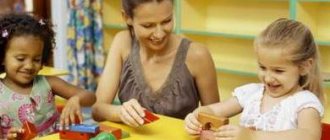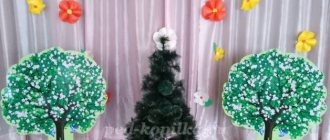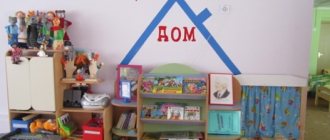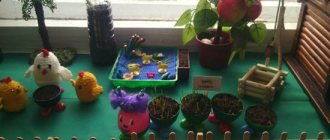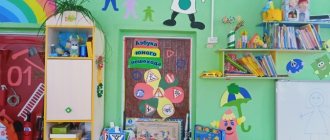How to choose a topic for self-education?
There are only two main criteria:
- requirement to study the topic from the outside (formulated in regulatory documents, in particular, in the Federal State Educational Standard for Preschool Education);
- the work of the teacher himself (lack of experience and knowledge to resolve a particular pedagogical situation).
Thus, before choosing a topic, you need to familiarize yourself with the regulatory framework for preschool education and analyze your own experience.
According to the Federal State Educational Standard, a preschool child develops in the following areas:
- social and communicative;
- educational;
- speech;
- artistic and aesthetic;
- physical.
Approximate topics of self-education for a preschool teacher according to the Federal State Educational Standard (2017 and later)
In accordance with the identified areas, topics on self-education for kindergarten teachers according to the Federal State Educational Standard can be as follows:
- Methods and means of amplification of preschool child development.
- Pedagogical diagnostics in a preschool institution.
- Individual approach in preschool education.
- Means and methods of developing safe life skills in preschoolers.
- Development of emotional intelligence in preschoolers.
- Guiding the play activities of preschool children.
- Cultivating kindness in preschoolers.
- Raising responsiveness in preschool children.
- Fostering sense of purpose in preschool children.
- Cultivating honesty and truthfulness in preschoolers.
- Formation of ideas about the small homeland among preschoolers.
- Development of creative abilities in preschool children.
- Formation of prerequisites for educational activities in children of senior preschool age.
- Cultivating curiosity in preschoolers (in classes, in communication, play, work).
- Formation in preschoolers of ideas about the signs, qualities and properties of objects in the surrounding world.
- Familiarization of preschoolers with the biocenosis of a forest (meadow, pond).
- Formation of ideas about space in preschoolers.
- Formation of ideas about inanimate nature in preschool children (natural phenomena, seasons, change of day and night).
- Formation in preschoolers of ideas about the shape, size, spatial relationships of objects.
- Formation of the concept of number in preschoolers.
- Development of forms of communication in preschoolers.
- Development of coherent speech in preschool children (in communication, play).
- Teaching children 4-7 years old basic analysis of a literary work.
- Teaching preschoolers to retell literary works.
- Teaching preschoolers to read poems expressively.
- Creative storytelling in kindergarten.
- Literacy training in preschool educational institutions.
- Non-traditional techniques of visual activity in kindergarten.
- Health-saving technologies in preschool education.
- Formation of cultural and hygienic skills in children of early and preschool age.
- Formation of self-service skills in preschoolers.
- Creating psychological comfort in a preschool group.
- Computer technologies in preschool education.
- Continuity of preschool and primary education.
- Psychological and pedagogical assistance in the family in the education and development of preschool children.
In 2016, changes and additions were made to the Federal State Educational Standard, in particular, on the education of children with disabilities. In this regard, one of the self-education topics for kindergarten teachers according to the Federal State Educational Standard 2022 could be:
- "Inclusive education in preschool settings."
In addition to topics in a specific area, you can choose a topic related to the work of a preschool institution as a whole:
- Planning work in a preschool institution according to the Federal State Educational Standard.
- Developing subject-spatial environment in preschool educational institutions.
- Development of partial preschool education programs.
- Innovative forms of working with parents of preschool children.
The list of topics on self-education for kindergarten teachers according to the Federal State Educational Standard 2022 may include the following topics:
- Variability of preschool education services at the present stage.
- Experimental activities in preschool educational institutions.
- Quality of preschool education: evaluation criteria.
- Social relations in preschool education.
Self-education program for preschool teacher.project (middle group) on the topic
MKDOU "Chumlyak kindergarten"
PROGRAM
self-education
middle group teacher
for 2016 -2019
TOPIC: “PROJECT ACTIVITY AS A MEANS OF DEVELOPING COGNITIVE ACTIVITY OF CHILDREN OF MIDDLE PRESCHOOL AGE IN THE CONDITIONS OF IMPLEMENTING THE FSES DO”
Educator: MASHKOVA OKSANA VLADIMIROVNA
With. Chumlyak, 2022
TOPIC: “Project activities as a means of developing the cognitive activity of children of middle preschool age in the context of the implementation of the Federal State Educational Standard for Education”
DIRECTION: social and personal
GROUP: average (4 -5 years)
TEACHER: Mashkova Oksana Vladimirovna.
STARTING DATE OF WORK ON THE TOPIC: September 2016
COMPLETION: August 2022
FORM OF SELF-EDUCATION: individual.
PURPOSE: study and implementation into active practice of a system of work on the development of cognitive activity of preschoolers through project activities.
TASKS:
- Increase your own level of knowledge by studying the necessary literature, visiting educational institutions, working with a bank of pedagogical information on the Internet;
- Develop and implement a strategy for interaction with parents, a system of working with children, a long-term plan for working with children, etc.);
- Prepare and conduct pedagogical diagnostics at the beginning and end of the school year;
- Create a modern subject-spatial environment in the group;
- Develop projects for the cognitive development of children, create a bank of short-term and long-term projects;
- Summarize your teaching experience and disseminate it through speaking at the pedagogical council, participating in seminars, conducting a master class for teachers, open classes with children, and participating in Internet competitions.
EXPECTED RESULTS:
As a novice teacher-educator, I will develop the foundations of pedagogical skills, professionalism and creativity:
- the ability to analyze scientific and methodological literature, increasing one’s theoretical and practical knowledge, skills and abilities;
- mastering innovative pedagogical technologies for raising and teaching children of middle preschool age (project activities);
- the ability to activate creative abilities and promote one’s achievements, apply acquired knowledge in practice;
- replenishment of professional achievements, creation of a portfolio for a middle school teacher.
Children will develop:
- creativity, communication skills, ability to experiment, apply acquired knowledge in practice;
- social skills in the process of group interactions, experience in research and creative activities;
- the degree of independence, initiative and cognitive motivation will increase.
For parents of students:
- there will be interest in joint research, preparation for upcoming creativity and production of the final product;
- interest in presenting family projects that provide a situation of success for every family.
MAIN QUESTIONS:
- history and essence of project activities;
- the relevance of the use of design and research activities in preschool educational institutions;
- goals and objectives of project activities for children of middle preschool age;
- methodology for organizing research and experimentation of preschool children;
- stages of work on the project;
- predicted results;
- groups of skills formed by the project method;
- features of research projects for children of middle preschool age;
- the role of parents in project activities;
- practical implementation of projects;
- further development of the project.
STUDYING EDUCATIONAL AND METHODOLOGICAL LITERATURE.
- Bederkhanova V.P. Joint design activity as a means of development of children and adults // Personal Development 2000 No. 1.
- Belaya, K.Yu. Self-education of preschool teachers / K.Yu. White // Directory of a senior teacher. - 2007. - No. 2.
- Veraksa N. E., Veraksa A. N. Project activities of preschoolers. A manual for teachers of preschool institutions - M.: Mozaika - Sintez, 2008.
- Vinogradova N.A., Pankova E.P. Educational projects in kindergarten. A manual for educators/N.A. Vinogradova, E.P. Pankova. – M.: Iris-press, 2008. (Preschool education and development).
- Derkunskaya V.A. Project activities for preschoolers. Educational and methodological manual. Publisher: Center for Teacher Education, 2013
- Dyachenko O.M., Veraksa N.E. Something that doesn't happen in the world. - M.: Knowledge, 1994.
- Dybina O.V., Yenik O.A. Problems of preschool education at the present stage: Issue 5 / Comp. O.V. Dybina, O.A. Yenik. – Tolyatti: TSU, 2007.
- Zakharova M.A. Project activities in kindergarten: parents and children. Publisher: School Press, 2010
- Kiseleva L.S., Danilina T.A., Lagoda T.S., Zuikova M.B. Project method in the activities of preschool institutions: A manual for managers and practical workers of preschool educational institutions / Author: L.S. Kiseleva, T.A. Danilina, T.S. Lagoda, M.B. Zuikova. – 3rd ed. pspr. and additional – M.: ARKTI, 2011.
- Makhaneva, M.D. Self-education of teachers / M.D. Makhaneva // Management of a preschool educational institution. - 2004. - No. 1.
- Menshchikova L. N. Experimental activities of children 4-6 years old. Volgograd, 2008.
- Morozova L.D. Pedagogical design in preschool educational institutions: from theory to practice. – M.: TC Sfera, 2010.
- Ryzhova N.A. The program “Our home is nature” block of lessons “sand, clay, stones”. toddler - didactics Moscow 2005.
- Solodyankina O.V. Design system in a preschool institution // methodological manual. - M.: ARKTI, 2010.
- Urmina I.A. Innovative activities in preschool educational institutions: programs - method. provision: hand aid. and adm. workers / I.A. Urmina, T.A. Danilina. – M.: Linka-Press, 2009.
- Shtanko I.V. Project activities with children of senior preschool age. // Management of a preschool educational institution. 2004, No. 4.
- Studying articles, notes on self-education and project activities on Internet sites: , www.maam.ru, https://doshvozrast.ru,
https://portalpedagoga.ru, https://dohcolonoc.ru, etc.
RELEVANCE:
Today, design occupies a special place in preschool education. In modern pedagogy, the project method is used along with systematic subject teaching as a component of a productive education system. The main goal of the project method in preschool institutions is the development of the child’s free creative personality, which is determined by the developmental tasks and tasks of children’s research activities.
The project method can be represented as a way of organizing a pedagogical process based on the interaction of a teacher, a student and his parents, a method of interaction with the environment, step-by-step practical activities to achieve a set goal (Kiseleva L.S., Danilina T.A., Pakhomova N. Yu.), i.e. This is a way to achieve a didactic goal through a detailed development of the problem, which should end in a very real, tangible practical result, formalized in one way or another.
A project is a goal accepted and mastered by children, relevant to them; it is a children’s initiative, it is a specific practical creative activity, a step-by-step movement towards a goal, it is a method of pedagogically organized development of the environment by a child. The project activity of a preschool child is “an activity to create, on the initiative of the child, together with adults, a socially significant product” (N.E. Veraksa).
Thus, the goal of organizing project activities for preschoolers is to create conditions for the child’s development that open up opportunities for his positive socialization, his personal development, the development of initiative and creative abilities based on cooperation with adults and peers in the process of project activities.
The choice of the topic of project activity is not accidental, since in middle age children have no life experience, an insufficient level of development of intellectual and creative abilities, which does not allow them to fully demonstrate independence in choosing a problem and solving it. Cognitive interest is increased and only through the organization of project activities can the child’s needs for independent activity be satisfied.
And also project activities make the educational system of a preschool educational institution open to the active participation of parents.
PERSPECTIVE SELF-EDUCATION PLAN
FOR THE 2017-2018 SCHOOL YEAR.
| Term | Stage | The content of the work | Reporting form |
| September October | Organizational and theoretical (preparatory) | Increasing your professional level, developing curiosity and cognitive activity:
| Consultation for parents “Main goals and objectives of the project method. Organization of project activities in the middle group." |
| October-April | Cumulative - practical (basic) | Using the project method in the practice of a preschool educational institution as an innovative pedagogical technology:
projects with middle school children
|
|
| May-July | Final (final) | Increasing the cognitive interest of preschool teachers, preschoolers and their parents in the project method:
|
|
BANK
PROJECTS IMPLEMENTED IN THE MIDDLE GROUP.
| Project classification | Duration | Subject | Month |
| short | "Autumn Fantasies" | October November |
| short | "Bird's Dining Room" | November December |
| long-term | "Usage educational games by V.V. Voskobovich in the educational process" | During a year |
| short | "New Year's Kaleidoscope" | December |
research | short | "Our cheerful garden" | March-June |
| short | "The magical world of Russian folk tales" | March, April |
| short | "Spring Laboratory" | April May |
| long-term | "I want to be healthy" | June July, during a year |
TECHNOLOGICAL MAP OF THE PROJECT
"AUTUMN FANTASIES"
PROJECT TYPE - family, creative
IMPLEMENTATION TIME – 2 months
PARTICIPANTS - teacher, middle group students, parents
THE FINAL PRODUCT is the design of a children’s and parent’s exhibition on the theme of the “Autumn Fantasy” project through the creation of collages, crafts from natural materials, vegetables, and fruits.
Project presentation.
GOAL: to expand children’s understanding of autumn as a season, to help them see the beauty of autumn nature and the wealth of autumn gifts, to create conditions for the artistic and aesthetic education of children, the development of their cognitive and creative abilities.
TASKS:
- Educational: enrich children’s ideas and knowledge about seasonal changes in nature in the fall, about the “gifts of autumn,” expand their vocabulary;
- Developmental: develop the ability to observe living objects and inanimate natural phenomena in the autumn;
Learn to reflect observations and acquired knowledge about various types of activities;
- Educators: cultivate the ability to admire autumn nature, feel its beauty, develop the desire and ability to preserve the natural world around us.
Involve parents in the pedagogical and creative process of the group’s work, enriching child-parent relationships with the experience of joint creative activity.
EXPECTED RESULTS:
-enrichment and expansion of children’s knowledge about autumn; activation of children's vocabulary on this topic;
— use of acquired knowledge in gaming activities;
— joint activities with children to create the exhibition “Autumn Time”;
— active involvement of parents in the implementation of the project.
TECHNOLOGICAL MAP OF THE PROJECT
"BIRD DINING"
PROJECT TYPE - family, creative
IMPLEMENTATION TIME – 2 months
PARTICIPANTS - teacher, middle group students, parents
FINAL PRODUCT - bird feeders made by parents and children of the middle group.
Presentation of the project with a photo report.
GOAL: to develop the ideas of parents and children about effective help and care for birds, to make feeders.
TASKS:
- Educational:
-introduce children to wintering birds in our village;
- deepen children’s knowledge about birds through illustrations, works of art, reference books and books;
- Educational:
-develop joint creativity of the teacher, parents and children.
- Educators:
— to promote in children good feelings, interest and love for birds;
EXPECTED RESULTS:
- a student who has an idea of wintering birds;
- able to make a feeder from different materials together with adults;
-knows what food to feed the birds; - parent, active participant in the project;
- able to instill in children love and respect for birds.
TECHNOLOGICAL MAP OF THE PROJECT
“USE OF DEVELOPMENTAL GAMES V.V. VOSKOBOVICH IN THE EDUCATIONAL PROCESS"
PROJECT TYPE - gaming
IMPLEMENTATION TERM - long-term, during the academic year.
PARTICIPANTS - teacher, middle group students, parents
FINAL PRODUCT - presentation of the project, open lesson with children, master class with teachers at the RMO.
GOAL: development of intellectual and creative abilities of children of middle preschool age.
TASKS:
- Educational:
- development of a child’s cognitive interest, desire and need to learn new things.
- Educational:
- development of imagination, creativity of thinking (the ability to think flexibly, originally, to see an ordinary object from a new angle);
- development of fine motor skills and all mental processes.
- Educators:
- self-confidence, desire to come to the aid of a fairy-tale character.
EXPECTED RESULTS: the use of these games in the pedagogical process allows you to rebuild educational activities: move from the usual activities with children to cognitive gaming activities.
TECHNOLOGICAL MAP OF THE PROJECT
"NEW YEAR'S KALEIDOSCOPE"
PROJECT TYPE - creative, family
COMPLETION TIME – 1 month
PARTICIPANTS - teacher, music director, middle group students, parents
FINAL PRODUCT - decorating the group with children's and family crafts for the New Year celebration.
Presentation of the project, participation in the Internet competition.
GOAL: to create an atmosphere of kindness, joy and mystery on the eve of the New Year, to develop the emotional responsiveness of children, to increase the creative activity and cohesion of teachers, children and parents of the middle group, to decorate the group festively.
TASKS:
- Educational:
-involve in the traditions of the New Year holiday.
- Educational:
-develop children's creative abilities through various activities.
- Educators:
- to instill in children a sense of satisfaction from participating in collective preparation for the holiday;
— encourage parents to engage in joint creative activities with their children.
EXPECTED RESULTS:
- children’s understanding of the traditions of New Year celebrations will expand;
- the vocabulary of pupils will be replenished;
- parents will become active and interested in the educational process of children;
- festively and beautifully decorated group.
TECHNOLOGICAL MAP OF THE PROJECT
"OUR FUN VEGETABLE GARDEN"
PROJECT TYPE – educational – research
IMPLEMENTATION TIME – 4 months
PARTICIPANTS - teacher, middle group students, parents
THE FINAL PRODUCT is the design of a mini-vegetable garden on the windowsill with planted cultivated plants and flowers. Presentation of the project, participation in the Internet competition with a photo report.
PURPOSE: observing the growth of plants, participating in plant care, planting seedlings in open ground on the territory of the kindergarten and harvesting.
TASKS:
- Educational:
-encourage children to observe the development of the same objects for a long time;
-clarify the idea that plants grow from seeds.
- Educational:
-summarize children’s ideas about the need for light, heat, moisture, soil for plant growth.
- Educators:
Cultivate a caring attitude towards your work.
EXPECTED RESULTS:
- children’s acquisition of experience in their own research activities;
-implementation of acquired new knowledge in life;
— active participation of parents in the project;
- participation of children in planting seedlings in open ground, harvesting, a beautiful flower garden on the territory of the kindergarten.
TECHNOLOGICAL MAP OF THE PROJECT
“THE MAGICAL WORLD OF RUSSIAN FOLK TALE”
PROJECT TYPE – creative, gaming
IMPLEMENTATION TIME – 2 months
PARTICIPANTS-teacher, middle group students, parents
FINAL PRODUCT -
GOAL: education of moral qualities of children through Russian folk tales.
TASKS:
- Educational:
- to stimulate children's interest in Russian folk tales.
- Educational:
- develop the ability to think, compare, analyze the actions of fairy-tale characters, learn to evaluate the behavior of your own and others.
- Educators:
— to form an idea of good and evil, to show the beauty of good deeds and their necessity in people’s lives;
— To help parents understand the value of a fairy tale, its special role in raising children.
EXPECTED RESULTS:
— children have developed an interest in Russian folk tales.
— the group has created the necessary conditions for getting acquainted with Russian folk tales.
- children are able to analyze the actions of fairy-tale characters and peers.
— children have an idea of good and evil, they always strive to help each other.
— parents understand the value of fairy tales and use them in raising their children.
TECHNOLOGICAL MAP OF THE PROJECT
"SPRING LABORATORY"
PROJECT TYPE – educational – research
COMPLETION TIME – 1 month
PARTICIPANTS - teacher, middle group students
FINAL PRODUCT - presentation of experience, photo report on the experiments performed.
GOAL: to develop interest in research and experimentation, to study the properties of water, air, sand, paper and other materials.
TASKS:
- Educational:
-learn in practice to identify the physical qualities of water, air, sand, paper and other materials;
-to form children’s cognitive interests and desire to experiment;
- learn to draw conclusions based on the experiment.
- Educational:
-develop cognitive activity;
- develop speech, enrich vocabulary: laboratory, laboratory assistant, scientific experiment, invention, continue to learn to answer questions in complete sentences;
-develop logic, memory, attention.
- Educators:
— to cultivate interest in the profession of a scientist, the desire to experiment, to independently explore the world.
EXPECTED RESULTS:
-children will become familiar with some of the properties of water, air, sand, paper and other materials;
-children will learn to do basic experiments and, with a little help from the teacher, formulate hypotheses and conclusions;
-children will develop search activity, increase their level of proficiency in coherent speech, and expand their vocabulary; Pupils will become more inquisitive and will be more careful about the materials they use.
TECHNOLOGICAL MAP OF THE PROJECT
"I WANT TO BE HEALTHY"
PROJECT TYPE – information-practice-oriented
IMPLEMENTATION DATE – (June–July), during the academic year
PARTICIPANTS - teacher, physical education instructor, music director, middle group students.
FINAL PRODUCT - design of the photo story “Journey to the Land of Health”, presentation of the project, production of the “Aibolit Corner” stand.
GOAL: to maintain and strengthen the health of children.
TASKS:
- Educational:
- to form an understanding of the need to take care of your health, protect it, learn to be healthy and lead a healthy lifestyle;
- Educational:
-develop basic self-healing skills.
- Educators:
— instill a love of physical exercise and hardening;
— to increase the literacy of parents in matters of education and health promotion of preschool children.
EXPECTED RESULTS:
-expanding children's knowledge about health;
- awareness by adults and children of the concept of “health” and the influence of lifestyle on the child’s health;
— increasing the level of orientation to modern living conditions;
- mastering self-healing skills;
- reduction in morbidity rates.
How to work by topic
Work on each of the listed topics begins with an analysis of the literature (an approximate list of sources is given below). When reading books, the teacher identifies the main thoughts, ideas, and judgments of the authors. So, taking up the topic of using didactic games to develop safe life skills in children, the teacher:
- draws attention to the peculiarities of organizing didactic games in different age groups;
- content of work on life safety in preschool educational institutions.
Then the teacher thinks through or also takes from books potentially dangerous situations that need to be avoided, and based on the knowledge gained, compiles a card index of games. He develops games himself or takes them from sources. Systematized materials are tested in practice.
Self-education
Independence in play is formed gradually, in the process of playful communication with adults, older children, and peers. The development of independence largely depends on how the child’s life is organized in the game. Waiting until he starts playing on his own means deliberately hindering the development of a child’s personality.
One of the important pedagogical conditions that contribute to the development of play in a young child is the selection of games by age. But toys that adults like do not always have educational value for children.
For a game to be interesting for a child (and even for an adult, who will most likely often be his partner) it must be quite understandable and simple and logical according to the rules. The goal of the game should also be simple, understandable and, in principle, achievable. At the same time, it should have a very large, controlled variation in the development of the game’s plot and events. And the player (even a small one) must consciously choose and try to implement some specific option that is advantageous from his point of view. But at the same time, there must be a large element of chance, which makes the game emotional, levels out skill and makes winning possible even for a beginner. After all, if one player always wins and the other loses, the “always losing” player quickly loses the desire to play. And if the “master” is forced to give in all the time, the desire to play with him disappears. Randomness puts players in almost identical conditions. Luck gives chances to everyone, but who managed to realize them? And when a child beats “dad himself” and not because he gave in, but in a “fair battle” - there is no limit to delight.
The developmental side of the game cannot be discounted. A child, playing a board game, even the simplest one, develops his imagination, learns to count quickly, learns to make a decision and begins to understand the relationship between decision-making, his actions and their results. His erroneous actions are obvious to himself and he is already beginning to think about how not to repeat them or avoid them, he understands which situation is bad and which is good. He develops not only tactical, but also strategic thinking.
When purchasing a game, it is important to pay attention not only to novelty, attractiveness, cost, but also to pedagogical expediency. Before you make your next purchase, it's a good idea to talk to your son or daughter about what kind of game he needs. Often girls play only with dolls, so they are often deprived of the joy of playing games that develop ingenuity, resourcefulness, and creativity. Girls play with dolls either alone or only with girls. They have no common interests with boys and there are no prerequisites for the emergence of friendly relationships between children. Boys usually play with cars and children's weapons. Such toys also limit the circle of communication with girls. It’s better, when we are adults, not to divide games into “girls” and “boys”.
